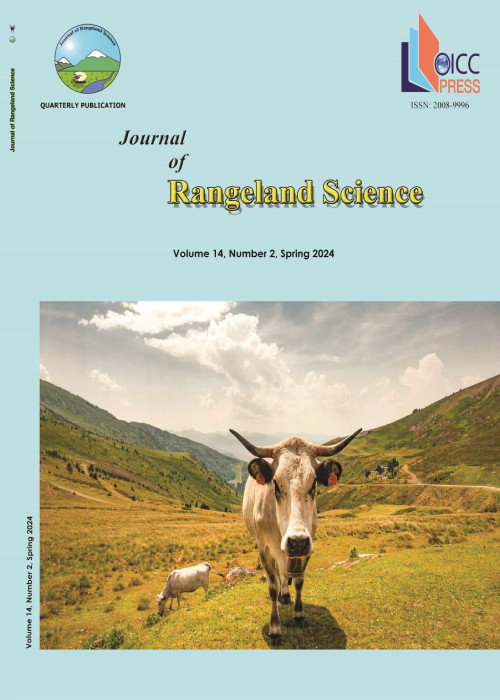The Influence of Cattle Grazing on Plant Species Composition in a Mesic Montane Region of Southern Africa
Author(s):
Article Type:
Research/Original Article (دارای رتبه معتبر)
Abstract:
This study investigated the effect of grazing on plant community structure. Two adjacent areas: one grazed for five years and non-grazed were sampled in March-April 2020. On each area, three sampling sites were selected. Quadrats of 1×1m were placed at 5m intervals along 50m transects (198~ 40 transects in total). Plants were identified and percentage cover was estimated following Braun-Blanquet method. Indicator values were calculated for each species. T-test compared the means between sites. Multi-response permutation procedures compared plant species composition between sites. Species richness (t=3.44, p<0.01) and evenness (t=-8.06, p<0.01) were significantly higher in non-grazed sites than grazed ones. Diversity showed the opposite trend (p<0.01). Mean cover differed (p<0.05) at species level. Density was significantly higher (t=6.93, p<0.01) in non-grazed sites than in grazed ones. Mean grass species richness was significantly higher (t= 2.97, p<0.01) in grazed sites than non-grazed ones while for herbs it was opposite (t=-5.94, p<0.01). 18 grass species were perennial while 1 was annual. Sporobolus pyramidalis (Low palatability, Increaser II) was found exclusively in the non-grazed areas, 7 others including Paspalum scrobiculatum (Moderate palatability, Increaser II) and Eragrostis curvula (Moderate palatability, Increaser II) were found in the grazed sites only and 11 were common to both sites. These include Themeda triandra (high palatability, Decreaser), Panicum natalense (low palatability, Decreaser), Eustachys paspaloides (high palatability, Decreaser) and Melinis repens. (Low palatability, Increaser II), Eragrostis racemosa (moderate palatability, Increaser II) and mean cover of P. natalense (t=-2.07, p<0.05), M. repens (t=-5.68, p<0.01) and E. racemosa (t=-7.54, p<0.01) was significantly higher in grazed areas than in non-grazed ones. Themeda triandra (t=13.0, p<0.01) and E. paspaloides (t=2.12, p<0.05) had significantly higher mean cover in non-grazed sites than in grazed ones. Our results indicate that grazing has negative impact on highly palatable species. We suggest long term monitoring of vegetation change.
Keywords:
Language:
English
Published:
Journal of Rangeland Science, Volume:13 Issue: 1, Winter 2023
Pages:
72 to 88
magiran.com/p2566784
دانلود و مطالعه متن این مقاله با یکی از روشهای زیر امکان پذیر است:
اشتراک شخصی
با عضویت و پرداخت آنلاین حق اشتراک یکساله به مبلغ 1,390,000ريال میتوانید 70 عنوان مطلب دانلود کنید!
اشتراک سازمانی
به کتابخانه دانشگاه یا محل کار خود پیشنهاد کنید تا اشتراک سازمانی این پایگاه را برای دسترسی نامحدود همه کاربران به متن مطالب تهیه نمایند!
توجه!
- حق عضویت دریافتی صرف حمایت از نشریات عضو و نگهداری، تکمیل و توسعه مگیران میشود.
- پرداخت حق اشتراک و دانلود مقالات اجازه بازنشر آن در سایر رسانههای چاپی و دیجیتال را به کاربر نمیدهد.
In order to view content subscription is required
Personal subscription
Subscribe magiran.com for 70 € euros via PayPal and download 70 articles during a year.
Organization subscription
Please contact us to subscribe your university or library for unlimited access!


